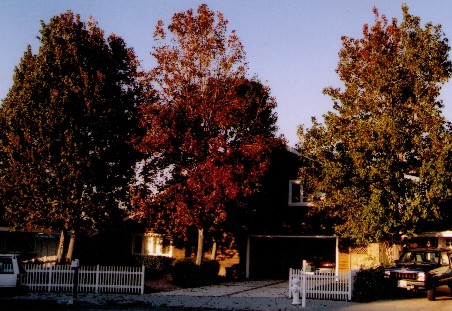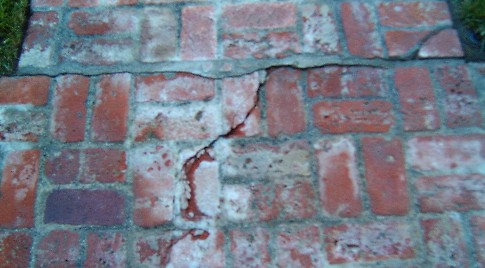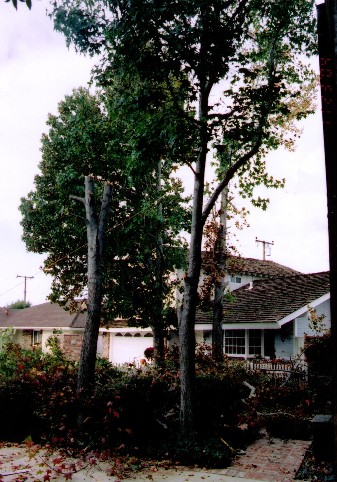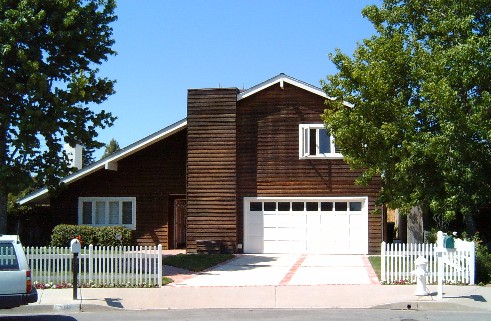That's the English die, not the German die. In response to a gardening post by Calblog, who has a Liquid Amber tree causing some interference with a citrus tree, I thought I would relate my bad experiences with these trees so anyone who is even thinking about planting them will reconsider.
As Justene pointed out in an email conversation, they are, indeed, beautiful trees. They are one of the few species in Southern California that will go through the full fall spectrum, giving those who grew up with an actual change of seasons a hint of what they are missing in the constant springtime of Southern Cal.
But the problem with Liquid Ambers is that they originated on the banks of rivers and streams, and developed a root system for that kind of environment. Because of this their roots aggressively seek out water, creating all sorts of hell for homeowners, as I found out first hand.
When I bought my house six years ago, I had four Liquid Ambers in my front yard and one close by in my neighbor's yard. I enjoyed them at first because of the fall colors and the autumn tradition of raking up leaves so the neighborhood kids could jump into them, causing me to start all over again. What is more fall-fun than that?

(there are two on the left and two in the middle, but they are right in front of each other, so you can sort of only see the two front ones)
The problems, however, slowly started manifesting themselves over time, and resulted in lots of money being spent:
o Incoming Water Main - The two trees in the middle sat right on top of the water main, which is buried a good 5-6 feet down. About four years into owning the house I noticed a lot of standing water in the front yard. I called out a plumber, and sure enough, we traced a leak back to the main - right under the trees. One solution was to rip out the trees and fix the line, but I didn't want to get rid of the trees (yet), so I ended up rerouting the water main, which required cutting off and abandoning the current line and putting in a new one through the open yard around the existing trees. Total cost: $1,000.
o Outgoing Sewer Line - The sewer line, which is buried underneath the old main line, started having periodic back-ups almost as soon as we moved in. These are a little easier to control since you can "rotor-router" out the pipe, which requires a plumber to snake a drill down your sewer pipe and drill out anything blocking the way. The line can then be kept clean - in theory - by periodically putting in root-killing chemicals. However, in my experience these either didn't work on Liquid Amnbers, or required a monthly application to keep them out. Total cost: a plumber is $300 for a drill-out, and I had to call about every other year. Chemicals are about $20 a treatment.
o Yard and Hardscape Issues - The trees choke out grass, making parts of the yard bare. In addition, as the roots branch out seeking water sources, they can crack sidewalks since they don't have a very deep slab.

This is one item which I am not planning on fixing until I redo the house's front facade, at which time I will also totally re-landscape the front yard, including the hardscape.
I lived with these for over five years, but it was yet another sewer line problem that pushed me over the edge. I threw up my arms and shouted at my wife "
We live in a house that's worth over $800,000 and I have a bathroom that keeps backing up because of roots!" It was time for the trees to die.
I called the landscaper who did my
Fabulous Back YardTM and he recommended Ramon, who was very good, and very cheap. The "cheap" got my interest, so I got a quote to remove the trees for the same cost as
trimming the trees from the local white contractor.
Before Ramon showed up, however, the neighbors found out about my plans. I don't know how, but word got out I was cutting them down. The morning of the planned cutting I got double-teamed by my two next-door neighbors, who begged me to at least keep one tree for now - at least until I relandscaped and put in a new tree. In the spirit of neighborliness I decided to keep the outer left tree, which would balance the tree on the right side of my house (but in my neighbor's yard), with the caveat that the last tree would come down when I relandscaped.
That little negotiation done, Ramon appeared and got to work, causing me watch my financial future flash before my eyes.
You see, there is a reason Ramon is cheap. Instead of a cherry picker and a large truck, his method consists of tying a Mexican to a rope, giving him a chainsaw, and sending him up the tree. The worker then becomes an acrobat on a line, swinging back and forth in the air, each swooping arc resulting in a branch being cut off by the buzzing chainsaw. If the line broke, the chainsaw hit an extremity, or if a large branch came crashing into my neighbor's roof, there were to be lawsuits in my future.
I was too grim to take a picture of the swinging acrobatic chainsaw juggling, but I did get a picture taken mid-work. The trees are cut off from the top down, leaving a 10' stump - for which they had further plans.

Once the stumps were left, they backed up a large hauling truck to the end of my driveway. They then put chains around the tree and tied it to the truck, put the truck in first gear and gunned it. I covered my eyes at this point, not knowing if the trunk would come out, the axel break, or my driveway come tearing out. Believe it or not, the trunks came out relatively easily, leaving nothing but dirt in the ground which I could then sod over. So while it was a harrowing experience, I have to say that Ramon DID know what he was doing, even if his techniques were a little unorthodox.

So I am down to one Liquid Amber on the far left side of my yard, which keeps it from doing too much damage. It too will go when I redo the out-of-place-Aspen-like facade on my home, but when that day comes I think I will pass on Ramon and pay the extra money for a little piece of mind during the extraction process.

 o The Cletus Factor - It's not every day you see grown men in overalls (shirt optional), but you see them in Texas. In fact I saw several hick stereotypes as soon as I stepped off the plane: overalls-no-shirt, the super skinny guy in a flannel shirt, overgrown full beard, and oil-stained "CAT" cap, you name it. California certainly has its share of slack-jaw yokels - but they blend in since they dress better and call themselves democrats.
o The Cletus Factor - It's not every day you see grown men in overalls (shirt optional), but you see them in Texas. In fact I saw several hick stereotypes as soon as I stepped off the plane: overalls-no-shirt, the super skinny guy in a flannel shirt, overgrown full beard, and oil-stained "CAT" cap, you name it. California certainly has its share of slack-jaw yokels - but they blend in since they dress better and call themselves democrats.


